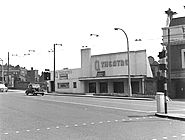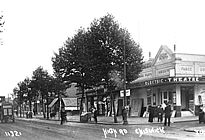The golden age of theatre and cinema in Chiswick
The
golden age of theatre and cinema in Chiswick
Gillian Clegg recalls the days when mega-stars
such as Laurel and Hardy, Vivien Leigh, James Mason and Dirk Bogarde performed
in West London
The Empire `died with dignity' on 20 June 1959 when a lame-jacketed Liberace played to a full house
When Oswald Stoll first proposed building a music hall in Chiswick in 1910, the idea was vehemently opposed by the local populace who claimed it would lower the tone and `drive away the better class inhabitants'. Stoll persevered, the opposition was overcome and the Chiswick Empire opened at 414 Chiswick High Road on 2 September 1912.
 The Chiswick Empire. The doors finally shut in 1959 |
The building
was designed by Frank Matcham, who also designed the London Palladium,
and could seat nearly 2,000 people. The decor was mainly electric blue
and terracotta and it had a sliding roof. This proved a mixed blessing
since it was rarely opened, and when it was, a cloud of dust descended
on the audience! Less than a year after its completion, the Empire suffered
a dreadful fire which destroyed the stage and damaged the auditorium.
It re-opened three months later, the decor now pale cream and old gold
with bottle green upholstery.
The Empire became one of the most prominent variety houses in the London
suburbs, staging plays, concerts, revues, music hall turns and also sometimes
opera and ballet. Particularly popular was the annual pantomime. Stars
who appeared at the theatre before the Second World War included Marie
Lloyd, Clara Butt, George Formby and Sybil Thorndyke. Like most theatres
it closed at the beginning of the War but re-opened in 1941 and famous
performers in the 40s and 50s included Laurel and Hardy, Vera Lynn, Arthur
Askey, Ken Dodd, Terry Thomas and Alma Cogan.
In early 1959 the building was sold and plans approved for an office block. The news that the theatre was to close came as a complete bombshell to the 30-strong staff, since the theatre had been playing to capacity audiences. The Empire `died with dignity' on 20 June 1959 when a lame-jacketed Liberace played to a full house. `A night of sadness at the Empire' was the headline in the Brentford and Chiswick Times the following week. The theatre was demolished a month later and the office block known as Empire House erected on the site.
 The Q Theatre. Stood opposite Kew Bridge Station Picture courtesy of John Gillham |
The Q Theatre (the name is a pun on Kew) stood opposite Kew Bridge Station on the site of what is now the block of flats called Rivers House. The theatre was converted from the Prince's Hall, which at various times had been a swimming pool, roller-skating rink and finally a film studio. The Q theatre was opened in 1924 by Jack and Beatrice de Leon. She was an aspiring actress who settled instead for a career in theatrical management; he a solicitor who became a talented playwright and director.
Due to the
de Leons' astute management, the Q became one of the most important of
London's small theatres (it could seat 490 peple), staging many plays
that went on to become West End hits. The first works of aspiring playwrights
such as Terence Rattigan and William Douglas Home were performed at the
Q, and such luminaries as Vivien Leigh, Dirk Bogarde, Joan Collins, Anthony
Quayle and Margaret Lockwood trod the boards here first. In the 1950s
the Q Theatre fell on hard times: television was coming in, Jack de Leon
died and the theatre needed major repairs. It closed in 1956.
Like most areas of the country, Chiswick embraced the new phenomenon of
‘moving pictures’ at the beginning of the 20th century. Chiswick's first
purpose-built, but shortest-lived, cinema was The Palais at No 365 Chiswick
High Road (the site is now occupied by Woolworth). This opened in October
1909, was fined in 1914 for Sunday opening and closed in 1916. It re-opened
briefly in 1919 with a name change to the Palace of Entertainments.
 The Electric Cinema, opened 1911 on the corner of Duke Road and Chiswick High Road Pictures courtesy of Local Studies Collection, Chiswick Public Library |
The Electric
Cinema was opened in 1911 on the corner of Duke Road and Chiswick High
Road. Various proprietors came and went – mainly into liquidation, which
caused the cinema to close periodically. In 1927 its name was changed
to The Coliseum and in 1929 it was converted for sound, but closed in
1932. It re-opened the same year specialising in newsreels when it was
known as the Tatler but its licence was finally revoked in 1933.
The emporium now known as Old Cinema Antiques at 160 Chiswick High Road
was formerly the Cinema Royal, but more affectionately known as The Cave
because of its decor and narrow entrance. At one time it sported a flashing
electric stalagmite outside. The building was originally the Chiswick
Hall, which was licensed for music and dancing in 1888. It opened as a
cinema in May 1912, was converted for sound but closed in August 1933.
Gillian Clegg is the author of Chiswick Past and Brentford Past and is the editor of the Brentford & Chiswick Local History Journal
Article originally published in Westside Magazine - republished with kind permission
December 27, 2003
Sign up for our free weekly newsletter
Related links
Related Links Brentford and Chiswick Local History Society All
the Society's Monday evening talks take place at the Chiswick Memorial
Club, Afton House, Bourne Place, Chiswick W4, starting at 7.30pm.
Remember that Afton House does not open until 7pm; please do not
expect to be let in before that time. Chiswick Memories - Chiswick High Road 1982 - 2003 Chiswick Pictures - don't miss the exhibition at Hogarth's House Chiswick Pictures - Historic Print of William's Terrace in 1837 Chiswick Pictures - Strand on the Green by Henry George Webb Chiswick Pictures - Chiswick Riverside from Harrison's History of London
|